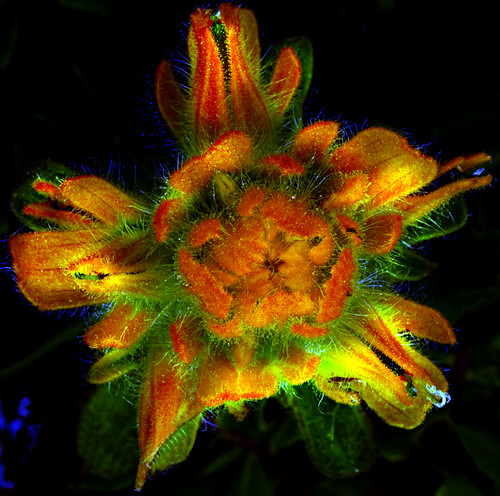
Indian Paintbrush, photo by Harold Davis. View this photograph larger.
It’s fairly well known that digital sensors are more sensitive to infrared (IR) than either film or the human eye. In fact, this is so much the case that digital cameras are equipped with a filter that screens out IR. You can capture IR photographs either by removing this factory-supplied CCD filter, or by adding your own filter to the camera.
Less appreciated is that digital sensors also can pick up more ultravioltet (UV) light waves than film or the human eye. As with IR, this effect can be amplified using filters. At the lower end of the UV spectrum, you’ll find xrays—so the ability to harness UV waves lets one “see” through, or inside things, a facility used in snooping and military devices that provide night vision.
Altogether, photographing light waves one cannot see is a crap shoot—you don’t really know what you are going to get. But in some circumstances so is taking normal photos with a digital camera, this photo being a case in point. It has been minimally processed in Photoshop from the RAW version.
Phyllis and I were hiking on the Chimney Rock Trail on Point Reyes (probably the most western trail in the continental United States). Rachel was taking care of the kids. We figured we hadn’t been hiking alone together in, well, eight or nine years—so a memorable occassion. It was early evening with a bright but low fog. This Indian Paintbrush was sitting by the edge of a headland cliff. The reds and greens of the flower glowed with an incredible intensity, and almost seemed to smolder, or vibrate. The image does not capture these colors. At the same time, the blue tendrils in the photo were not apparent to our human vision.
So intead of “beyond the visible,” maybe I should have called this story “making the unseen visible, and making the visible disappear.”
Pingback: Photoblog 2.0: » Photoblog 2.0 Archive: » Xrays, Photograms, and Cross Processing, Oh My!
Pingback: Photoblog 2.0: » Photoblog 2.0 Archive: » Night for Day
Pingback: Photoblog 2.0: » Photoblog 2.0 Archive: » Darkness Revealed